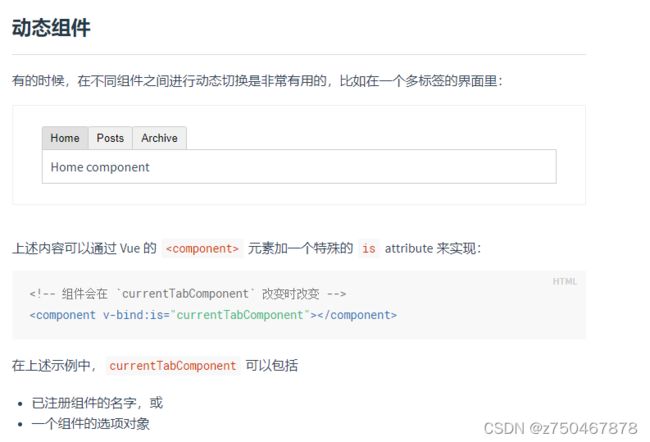Vue组件 知识点总结
文章目录
- 一、组件知识点
-
- 1. 组件的注册
- 2.组件中的属性
- 二,自定义属性
-
- 1.props的基本使用
- 2. props的验证
- 三,自定义事件
-
- 1.基础语法
- 2. 自定义事件的使用场景
-
- 2.1 子组件修改父组件的数据
- 2.2 子组件传值给父组件
- 四,组件案例
-
- 1. 组件版计数器
- 2. 组件版todolist
- 五,生命周期
- 六,插槽
-
- 1.基本用法
- 2. 作用域插槽
- 七,动态组件
一、组件知识点
1. 组件的注册
<body>
<div id="app">
<hello></hello>
<world></world>
</div>
<div id="root">
<hello></hello>
<world></world>//局部注册的组件world显示不出来
</div>
<script src="/vue.js"></script>
<script>
//全局注册组件(创建组件,要在new Vue之前)
Vue.component('hello', {
//组件的模板(组件要显示的标签)
template: `
Hello
`
});
//局部注册组件
new Vue({
el: '#app',
components: {
'world': {
template: `world
`
}
}
})
new Vue({
el: '#root'
})
</script>
</body>
2.组件中的属性
<body>
<div id="app">
<my-component></my-component>
</div>
<script src="/vue.js"></script>
<script>
//创建全局组件:
Vue.component('my-component',{
template:`
{{msg}}
{{newMsg}}
`,
//和之前一样data,computed等都能用
data(){
return{
msg:'你好呀'
}
},
computed:{
newMsg(){
return '我不好'
}
}
});
//为什么组件中data()只能用函数返回的形式:
//因为组件要多次使用,以保证每个组件用的data独立
//使得每个实例可以维护一份被返回对象的独立的拷贝(官方的话)
// const a = data();
// const b = data();
new Vue({
el:'#app',
})
</script>
</body>
二,自定义属性
1.props的基本使用
Vue中为组件提供了一个props 的属性,在组件上注册的一些自定义属性,通过props,使得父组件向子组件传值。
注意:当父组件向子组件传递数据时,除了字符串,其他所有数据类型都需要通过v-bind 来进行传递。
<body>
<div id="app">
<father></father>
</div>
<script src="/vue.js"></script>
//父子组件的前提是有嵌套关系。 注意:局部组件不能嵌套到全局组件中。
//1.父组件传值:父组件中,给子组件设置属性,进行传值。
<script>
Vue.component('father', {
template: `
2. props的验证
props 可以通过设置成对象的形式,来进行props的验证。
<body>
<div id="app">
<father></father>
<hr>
<hr>
<child></child>
</div>
<script src="/vue.js"></script>
<script>
Vue.component('father', {
template: `
father
{{msg}}
child
{{name}} {{age}} {{gender}}
`
})
new Vue({
el: '#app'
})
</script>
</body>
三,自定义事件
1.基础语法
- 在父组件的 methods属性中定义事件的方法,然后在调用子组件时,通过
@自定义名称=方法名,来向子组件传递自定义事件。 - 子组件通过
@事件类型="$emit('自定义事件名称')”来触发父组件传递的自定义事件。
<body>
<div id="app">
<father></father>
</div>
<script src="/vue.js"></script>
<script>
Vue.component('father',{
template:`
child
`
})
new Vue({
el:'#app'
})
</script>
</body>
2. 自定义事件的使用场景
2.1 子组件修改父组件的数据
在父组件中定义一个修改父组件数据的方法,然后通过自定义事件将该方法传递给子组件,让子组件来触发该方法。
<body>
<div id="app">
<father></father>
</div>
<script src="/vue.js"></script>
<script>
Vue.component('father',{
template:`
{{num}}
2.2 子组件传值给父组件
当子组件想要将数据传递给父组件时,通过调用父组件的方法,来进行数据的传递。
<body>
<div id="app">
<father></father>
</div>
<script src="/vue.js"></script>
<script>
Vue.component('father',{
template:`
{{num}}
四,组件案例
1. 组件版计数器
<body>
<div id="app">
//父组件counter中包含了两个子组件
<counter></counter>
</div>
<script src="/vue.js"></script>
<script>
//注意:组件名需要加引号
Vue.component('counter', {
template: `
//自定义属性
计数器:{{count}}
`
})
//子传父
//@blur是当元素失去焦点时所触发的事件
Vue.component('set-count', {
template: `
//给input加了ref属性
`,
methods: {
inputCount() {
const value = this.$refs.newCount.value;
this.$emit('inputCount', value);
this.$refs.newCount.value = '';
}
},
})
new Vue({
el: '#app',
})
</script>
</body>
假设:在vue 中,需要操作DOM了,需要拿到页面上某个DOM元素的引用,此时怎么办?
答:ref引用,ref用来辅助开发者在不依赖于jQuery的情况下,获取DOM元素或组件的引用。
注意:每个vue的组件实例上,都包含一个 $refs对象,里面存储着对应的DOM元素或组件的引用。默认情况下,组件的 $refs指向一个空对象。
2. 组件版todolist
<style>
.done {
color: red;
text-decoration: line-through;
}
.btnsName>*{
margin-right: 10px;
}
</style>
<body>
<div id="app">
<todolist></todolist>
</div>
<script src="/vue.js"></script>
<script>
//父组件:
Vue.component('todolist', {
template: `
-
{{item.text}}
`,
})
Vue.component('btns', {
props:['current','total','doneTotal'],
data(){
return{
btnsName:['ALL','DONE','ACTIVE'],
}
},
template: `
`
})
new Vue({
el: '#app'
})
</script>
</body>
五,生命周期
<body>
<div id="app">
<h1>{{msg}}</h1>
<button @click="msg='我不好'">按钮</button>
<button @click="$destroy()">销毁</button>
</div>
<script src="/vue.js"></script>
//created,mounted:页面初始化时向服务端发起请求。
<script>
new Vue({
el: "#app",
data() {
return {
msg: "你好"
}
},
beforeCreate() {
console.log('创建前');
},
created() {
console.log('创建完成');
},
beforeMount() {
console.log('挂载前');
},
mounted() {
console.log('挂载完成');
},
beforeUpdate() {
console.log('数据更新前');
},
updated() {
console.log('数据更新完成');
},
beforeDestroy() {
console.log('销毁前');
},
destroyed() {
console.log('销毁完成');
}
})
</script>
</body>
六,插槽
1.基本用法
//知识点:
1.插槽的内容:从组件外部向组件内部的插槽添加内容。
2.插槽的默认值:当没有给插槽传递数据时,默认插槽内容为空,给插槽手动设置默认值,页面就显示插槽的默认值。
3.具名插槽:一个组件中,有多个插槽时,可以通过name属性给插槽设置名字。
<body>
<div id="app">
<cpn>
//具名插槽的v-slot只能写在template中
<template v-slot:header>
<h3>插槽的内容</h3>
</template>
<template v-slot:footer>
//没有给插槽传递内容,显示插槽的默认值
</template>
</cpn>
</div>
<script src="/vue.js"></script>
<script>
Vue.component('cpn', {
template:`
文章一
文章二
文章三
插槽的默认值
`
})
new Vue({
el: '#app'
})
</script>
</body>
2. 作用域插槽
当插槽中渲染的数据由插槽所在的子组件提供,而插槽显示的标签由父组件提供,这种情况下就需要用到作用域插槽。
//用无序列表和有序列表渲染学生列表students
<body>
<div id="app">
<father></father>
</div>
<script src="/vue.js"></script>
<script>
Vue.component('father', {
template:`
- {{item}}
- {{item}}
`
});
Vue.component('child', {
data(){
return{
students:['张三','李四','王五']
}
},
template:`
学生列表
七,动态组件
案例:
<body>
<div id="app">
<tabs></tabs>
</div>
<script src="/vue.js"></script>
<script>
Vue.component('tabs',{
data() {
return {
current:'Home'
}
},
//标签:切换组件不会重新渲染
template:`
`
})
Vue.component('Home',{
template:`
Home的组件内容
`
})
Vue.component('About',{
template:`
About的组件内容
`
})
Vue.component('Posts',{
template:`
Posts的组件内容
`
})
new Vue({
el:'#app'
})
</script>
</body>





